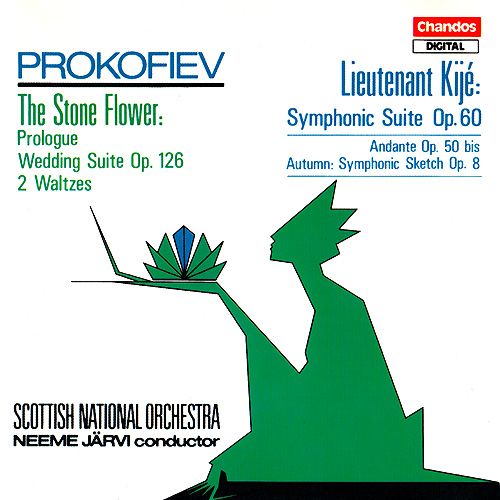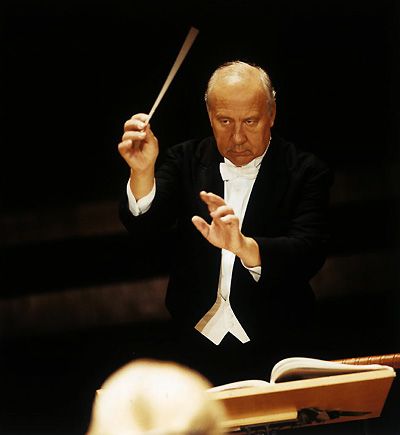wimpel69
11-13-2014, 01:36 PM
EAC-FLAC link below. This is my own rip. Complete artwork,
LOG and CUE files included. Do not share. Buy the original!
Please leave a "Like" or "Thank you" if you enjoyed this!
Sergei Prokofiev's final ballet, The Stone Flower, was conceived at a time when the composer's
health was in serious decline and his reputation with Soviet authorities in tatters. In January 1948, the composer --
along with such prominent Soviet colleagues as Shostakovich and Khachaturian -- was summoned to appear
at a meeting of the Central Committee of the Communist Party. The composers were attacked by Andrei Zhdanov
and other party overlords for writing formalist and anti-democratic music. It was reported that Prokofiev sat
defiantly with his back turned to the speaker as the charges were read. From this point, performances of his
works in the Soviet Union were rare. Moreover, until his death in 1953, he not only had to be wary of every
note he put to paper, but his precarious situation demanded that he also choose only inoffensive, politically
safe subject matter for his stage works. Not surprisingly, then, Prokofiev selected a fairy-tale theme for
his last ballet, setting it with appropriately light and colorful music.
The Stone Flower (1948-1953) takes place in the Ural Mountains, where the stonecutter Danilo temporarily
forsakes his betrothed, Katerina, to accompany the Mistress of Copper Mountain to her realm. There she
shows him a legendary flower made of stone. Danilo becomes determined to carve one like it in malachite,
a deep green marble-like mineral native to Russia. Meanwhile, Katarina is harassed by the story's villain, the
drunken Severyan. The Mistress of Copper Mountain captures him and compels the ground to open and
swallow him whole. Katarina searches for Danilo and finds him, but their reunion is spoiled when the
Mistress becomes upset that he wants to leave the mountain paradise now that he has learned the secret
of making the stone flower. In the end, however, Danilo gains the Mistress' respect through his love for
and fidelity to Katarina, and the lovers depart to live happily ever after.
As suggested above, Prokofiev's score, one of the most approachable of his major works, is rather direct
and uncomplicated. The work is rich with memorable tunes, most notably the one at the opening
associated with the Mistress of Copper Mountain, which recurs throughout the ballet. Three successive
dances present some of the most striking music in the score: No. 31 "Russian Dance," No. 32, "Gypsy
Dance," and No. 33, "Severyan's Dance." In the end, The Stone Flower may not rank with Prokofiev's
earlier ballet masterpieces, Romeo and Juliet (1935-1936) and Cinderella (1940-1944), but it is
distinguished by a certain melodic and rhythmic charm; and while it blazes no new compositional
trails, neither does it contain any obvious flaws. Prokofiev extracted three orchestral works from the
ballet in 1951: the Wedding Suite, Op. 126; Gypsy Fantasy, Op. 127; and Ural Rhapsody, Op. 128.
The composer died shortly after completing revisions to a pas de deux in the ballet's final act.
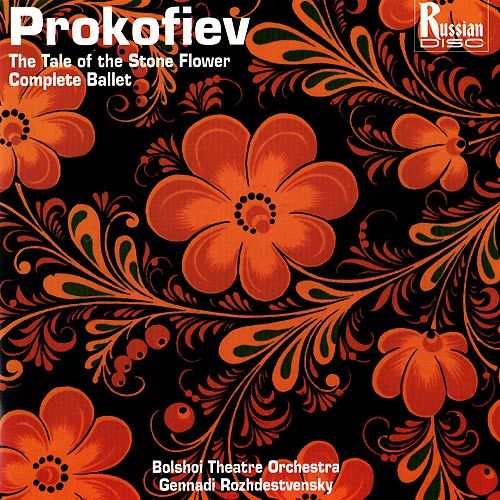
Music Composed by
Sergei Prokofiev
Played by the
Bolshoi Theatre Orchestra
Conducted by
Gennadi Rozhdestvensky
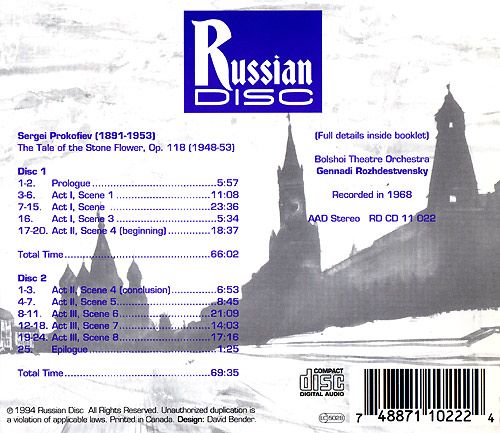
"Gennady Rozhdestvensky conducted the Bolshoi for this version, which appears to be an attempt to
recreate Prokofiev's intended ballet rather than Grigorovich's more well known version. It's performed
with some brutality - I only have an "excerpts" performance (from Chandos's excellent October
Cantata CD) to compare it to, but whereas the Philharmonia Orchestra's performance from the latter
treats, for example, the Ural Rhapsody as a smooth, flowing, steadily more dramatic, piece, the
Rozhdestvensky version is crude and violent, a theme that is common to much of the rest of the
ballet. This is understandable, this is not a "cute" ballet and even the events that lack menace -
such as the aforementioned Ural Rhapsody, which is played during a bustling market scene - are
hardly graceful. This is not to imply ugliness, just a more hard edged ballet than one might be
used to.
All in all I loved this performance, and this ballet. This is a very original piece, is wonderful to
listen to, and is intelligently interpreted. Definitely recommended!"
Amazon Reviewer
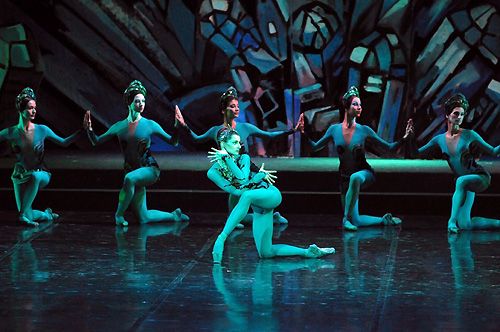
DOWNLOAD LINK (FLAC) - https://mega.co.nz/#!DFxUhb6b!x2UlpPPNLnzU2uQGgEk7c5uLY5HdDbIhG8coj0f qjxo
mp3 - https://mega.co.nz/#!WF5yDCxS!OA8zOkmL3Ni9uUdMKKZUZp3N083B2c5lSEXrNXC bYLU
Source: Russian Disc/Melodiya, 1994 (my rip!)
Formats: FLAC(RAR), AAD Stereo, Level: -5, mp3/320 (CBR)
File Sizes: 725 MB / 311 MB (FLAC version incl. artwork & booklet)
Enjoy! Don't share! Buy the origina! Please leave a "Like" or "Thank you" if you enjoyed this! :)
LOG and CUE files included. Do not share. Buy the original!
Please leave a "Like" or "Thank you" if you enjoyed this!
Sergei Prokofiev's final ballet, The Stone Flower, was conceived at a time when the composer's
health was in serious decline and his reputation with Soviet authorities in tatters. In January 1948, the composer --
along with such prominent Soviet colleagues as Shostakovich and Khachaturian -- was summoned to appear
at a meeting of the Central Committee of the Communist Party. The composers were attacked by Andrei Zhdanov
and other party overlords for writing formalist and anti-democratic music. It was reported that Prokofiev sat
defiantly with his back turned to the speaker as the charges were read. From this point, performances of his
works in the Soviet Union were rare. Moreover, until his death in 1953, he not only had to be wary of every
note he put to paper, but his precarious situation demanded that he also choose only inoffensive, politically
safe subject matter for his stage works. Not surprisingly, then, Prokofiev selected a fairy-tale theme for
his last ballet, setting it with appropriately light and colorful music.
The Stone Flower (1948-1953) takes place in the Ural Mountains, where the stonecutter Danilo temporarily
forsakes his betrothed, Katerina, to accompany the Mistress of Copper Mountain to her realm. There she
shows him a legendary flower made of stone. Danilo becomes determined to carve one like it in malachite,
a deep green marble-like mineral native to Russia. Meanwhile, Katarina is harassed by the story's villain, the
drunken Severyan. The Mistress of Copper Mountain captures him and compels the ground to open and
swallow him whole. Katarina searches for Danilo and finds him, but their reunion is spoiled when the
Mistress becomes upset that he wants to leave the mountain paradise now that he has learned the secret
of making the stone flower. In the end, however, Danilo gains the Mistress' respect through his love for
and fidelity to Katarina, and the lovers depart to live happily ever after.
As suggested above, Prokofiev's score, one of the most approachable of his major works, is rather direct
and uncomplicated. The work is rich with memorable tunes, most notably the one at the opening
associated with the Mistress of Copper Mountain, which recurs throughout the ballet. Three successive
dances present some of the most striking music in the score: No. 31 "Russian Dance," No. 32, "Gypsy
Dance," and No. 33, "Severyan's Dance." In the end, The Stone Flower may not rank with Prokofiev's
earlier ballet masterpieces, Romeo and Juliet (1935-1936) and Cinderella (1940-1944), but it is
distinguished by a certain melodic and rhythmic charm; and while it blazes no new compositional
trails, neither does it contain any obvious flaws. Prokofiev extracted three orchestral works from the
ballet in 1951: the Wedding Suite, Op. 126; Gypsy Fantasy, Op. 127; and Ural Rhapsody, Op. 128.
The composer died shortly after completing revisions to a pas de deux in the ballet's final act.

Music Composed by
Sergei Prokofiev
Played by the
Bolshoi Theatre Orchestra
Conducted by
Gennadi Rozhdestvensky

"Gennady Rozhdestvensky conducted the Bolshoi for this version, which appears to be an attempt to
recreate Prokofiev's intended ballet rather than Grigorovich's more well known version. It's performed
with some brutality - I only have an "excerpts" performance (from Chandos's excellent October
Cantata CD) to compare it to, but whereas the Philharmonia Orchestra's performance from the latter
treats, for example, the Ural Rhapsody as a smooth, flowing, steadily more dramatic, piece, the
Rozhdestvensky version is crude and violent, a theme that is common to much of the rest of the
ballet. This is understandable, this is not a "cute" ballet and even the events that lack menace -
such as the aforementioned Ural Rhapsody, which is played during a bustling market scene - are
hardly graceful. This is not to imply ugliness, just a more hard edged ballet than one might be
used to.
All in all I loved this performance, and this ballet. This is a very original piece, is wonderful to
listen to, and is intelligently interpreted. Definitely recommended!"
Amazon Reviewer

DOWNLOAD LINK (FLAC) - https://mega.co.nz/#!DFxUhb6b!x2UlpPPNLnzU2uQGgEk7c5uLY5HdDbIhG8coj0f qjxo
mp3 - https://mega.co.nz/#!WF5yDCxS!OA8zOkmL3Ni9uUdMKKZUZp3N083B2c5lSEXrNXC bYLU
Source: Russian Disc/Melodiya, 1994 (my rip!)
Formats: FLAC(RAR), AAD Stereo, Level: -5, mp3/320 (CBR)
File Sizes: 725 MB / 311 MB (FLAC version incl. artwork & booklet)
Enjoy! Don't share! Buy the origina! Please leave a "Like" or "Thank you" if you enjoyed this! :)
